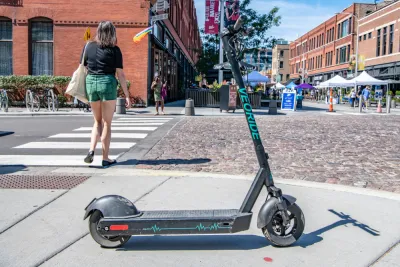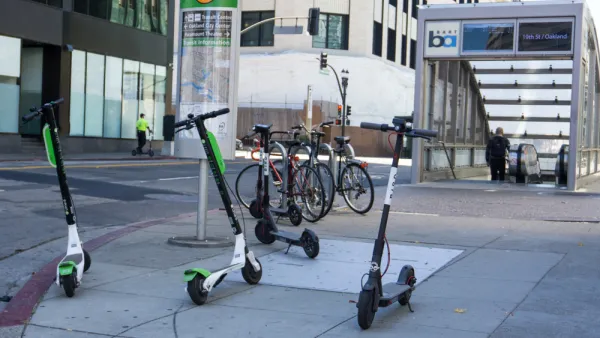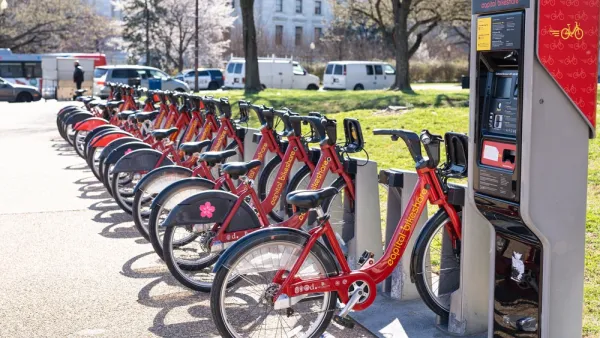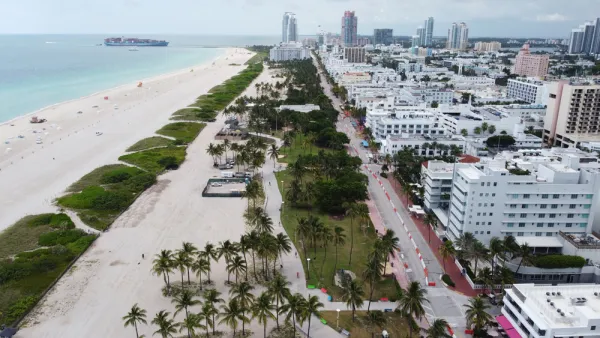As cities continue to adapt micromobility regulations to address new devices and technologies, what can we learn from Chicago's five years of e-scooter pilots?

Five years after shared e-scooter fleets first hit U.S. streets, Brandon Bordenkircher and Riley O'Neil assess the successes and challenges of scooter pilot programs around the country, particularly in Chicago. Speaking with city mobility leaders, the authors evaluate how the scooter companies fulfilled—or didn't—their early promises to cities.
Bordenkircher and O'Neil find that while many cities at first reacted by banning scooters, the devices have now become an important tool in improving mobility and providing options for underserved communities, but operators and cities have fallen short on safety and sustainability goals.
In Chicago, the city required that 50 percent of scooters would be placed in "equity zones," mandating coverage in low-income neighborhoods. However, equity advocates say increasing ridership also requires "community-led micromobility models such as neighborhood-based mobility hubs, non profit operators, and other innovative strategies that prioritize racial equity and mobility justice over profit."
When it comes to clutter and mobility, Chicago—which boasts some of the country's most robust bike parking infrastructure—requires scooter users to lock devices to a bike rack or other object, preventing the sidewalk clutter and inconvenience to pedestrians experienced in other cities.
While e-scooter fatalities remain rare, injuries are on the rise, and mobility advocates call on cities to improve infrastructure that would limit scooter-car interaction and reduce the chance of crashes. Meanwhile, despite claims that scooters provide a more environmentally friendly mobility option that can connect people to transit, the materials required to build the devices and the energy used in moving and collecting them, as well as the fact that many scooter trips could have been made by bike, on foot, or via public transit, mean that scooters do not make a meaningful impact on overall carbon emissions and resource use.
The article concludes that although the e-scooter industry has come a long way from its early days, more efforts are required to improve safety, equity, and sustainability and meaningfully integrate the devices into cities' transportation systems.
FULL STORY: Mobility leaders assess 5 years of e-scooters, and draw insights from the Chicago pilots

Analysis: Cybertruck Fatality Rate Far Exceeds That of Ford Pinto
The Tesla Cybertruck was recalled seven times last year.

National Parks Layoffs Will Cause Communities to Lose Billions
Thousands of essential park workers were laid off this week, just before the busy spring break season.

Retro-silient?: America’s First “Eco-burb,” The Woodlands Turns 50
A master-planned community north of Houston offers lessons on green infrastructure and resilient design, but falls short of its founder’s lofty affordability and walkability goals.

Test News Post 1
This is a summary

Analysis: Cybertruck Fatality Rate Far Exceeds That of Ford Pinto
The Tesla Cybertruck was recalled seven times last year.

Test News Headline 46
Test for the image on the front page.
Urban Design for Planners 1: Software Tools
This six-course series explores essential urban design concepts using open source software and equips planners with the tools they need to participate fully in the urban design process.
Planning for Universal Design
Learn the tools for implementing Universal Design in planning regulations.
EMC Planning Group, Inc.
Planetizen
Planetizen
Mpact (formerly Rail~Volution)
Great Falls Development Authority, Inc.
HUDs Office of Policy Development and Research
NYU Wagner Graduate School of Public Service




























